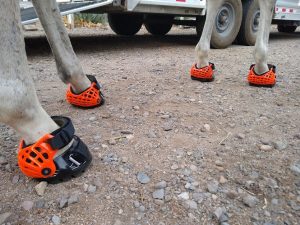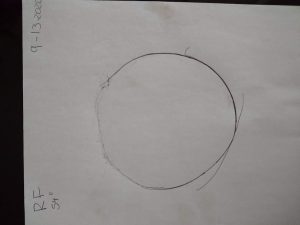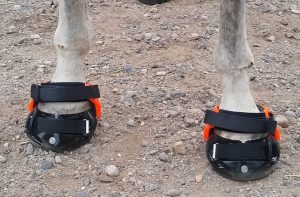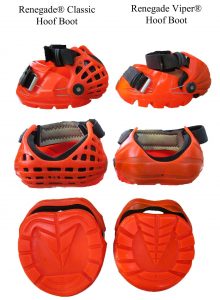 Sizing and Fitting Apollo: In order to size and fit Apollo for Renegade’s, I started with measuring his hooves. Getting accurate measurements is an important step. It is so easy to get a wrong measurement because the tape measure isn’t laying completely flat, or is not straight across the widest or longest part of the hoof. I find it works best to measure and then remeasure a second time. What is it that contractors always say; “measure twice, cut once”.
Sizing and Fitting Apollo: In order to size and fit Apollo for Renegade’s, I started with measuring his hooves. Getting accurate measurements is an important step. It is so easy to get a wrong measurement because the tape measure isn’t laying completely flat, or is not straight across the widest or longest part of the hoof. I find it works best to measure and then remeasure a second time. What is it that contractors always say; “measure twice, cut once”.
In addition to measuring, I also took some hoof drawings of each hoof. This is not as accurate because you are tracing on the outside of the hoofwall. I did this because I also wanted to see the overall shape of each hoof. It will also be good to have to compare to later. I wrote the date and also hoof angle for each hoof on each paper.

During this process, I was able to fit Apollo into some Classic Renegade’s that I already had on hand from my other horses. See this link on how to measure. I longed Apollo in the arena first, to make sure the boots would stay on. Then we went out on the trail and rode a little over 8 miles. The boots worked perfectly with no twists or any other issues.
After a bit of consulting it was determined that the best option for Apollo would be to use a Viper hoof boot bottom with a Renegade Classic captivator. Apollo’s hoof angles, at 54 degrees, are not quite as steep as my other horses. This is after I took a little more toe off. See this link on how to measure and size Vipers.
To give one example: Apollo’s RF is very round at 4 7/8″ wide and 5 1/16″ long. This puts him into a size 2 Renegade. It also puts him into a 135 x 130 Viper. The 130 mm measurement is the width, which works out to 5.11″. If I add 5 mm to Apollo’s 124 mm measurement, I get 129 mm. Remember that 5 mm is basically 1/5 of an inch. These boots generally allow a bit of play in them and work best if they are not tight versus being tight. Here is a description for how to calculate the sizing on a Viper:
The boot shell should not fit tightly. To determine the proper boot size, add 5mm (3/16″) to your width measurement and 5mm (3/16″) to your length measurement and compare it to the chart selecting the boot size with the closest measure. For most horses the width measurement is more critical than the length measurement and most horses will be fine with boots up to 10mm (3/8″) longer than actually measured. Horses that are known to travel close may need more careful length measurement selection, i.e. horses known to strike the back of the front hooves with their hind hooves.
 The Classic Renegade Captivator works better for Apollo’s heels. Here is a previous post on how to determine which heel captivator works best with different shaped heels. Apollo has somewhat contracted and underslung heels.
The Classic Renegade Captivator works better for Apollo’s heels. Here is a previous post on how to determine which heel captivator works best with different shaped heels. Apollo has somewhat contracted and underslung heels.
It only took a few days for the new Vipers to arrive. I shortened a couple of cables and got the boots fitted for Apollo. I again did some work in the arena with Apollo before taking him out on the trail.
We rode approximately 9 miles in the new Vipers with the Classic Captivators. We again had a flawless ride with no twists or other issues. Ultimately both boot models and both the Viper and Classic captivators worked for Apollo. I’m really happy with the configuration that we have now and can’t wait to give them more of a test in the coming weeks. We have been grounded due to the wildfire smoke on the west coast.
 Classic vs Viper Comparison and Differences
Classic vs Viper Comparison and Differences
Viper
The Viper is more rounded and has a wider profile at the toe.
Greater size range means being able to fit shapes that are more oval in proportion up to very round and symmetrical.
The shell profile is a little more lightweight and streamlined.
Tread is deeper and more aggressive. Very well suited for mud, grass, and rough terrain.
Captivators are best suited for horses with well-shaped, well-defined heel bulbs.
Renegade
Slightly narrower in profile overall, especially at the toe.
Wider and more open in the back of the boot, which will accommodate a more triangular/spade-shaped hoof better, and is typically a better option for a hoof that is wider than it is long.
Cutback options offered in the Classic will also allow a certain degree of modification to the boot length.
Tread is not quite as aggressive but is designed to still provide a good grip.
Some gaited horses with an inherent “slide” in their movement and hoof landing may do better with the slightly less aggressive option.
Captivators do not have as defined and rigid of a shape as the Viper captivators and are more forgiving in the heel bulb shapes that they fit.
Captivators can be swapped between boot styles. This is something to be discussed with customer service personnel to determine if a captivator style swap is necessary.
Both boot models were developed and designed for high-performance use. Ultimately, the best style is going to be the one that suits the horse’s hoof shape and measurements.
If you are reading this and have concerns about which boot model to choose, or if you need help with sizing do the following: Email support@renegadebootstore.comi with photos of the hooves with a tape measure showing the width x length on a fresh trim.
